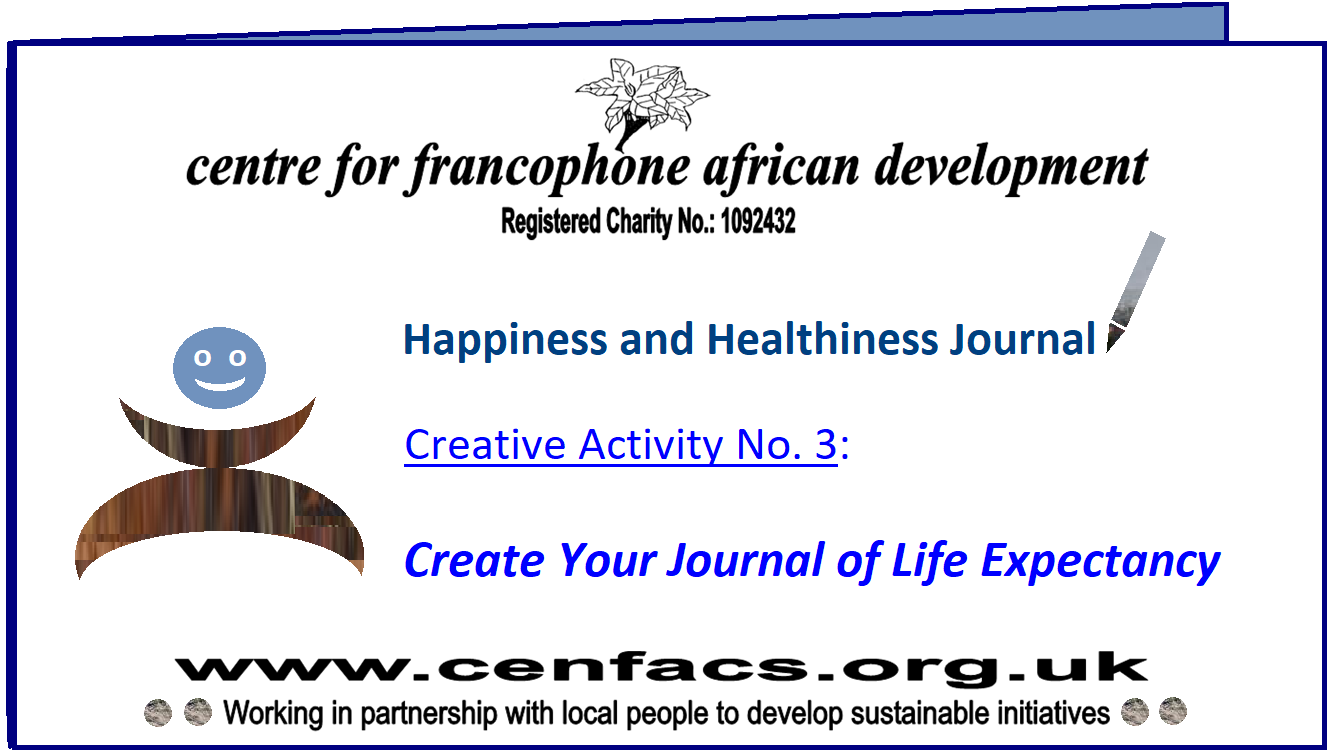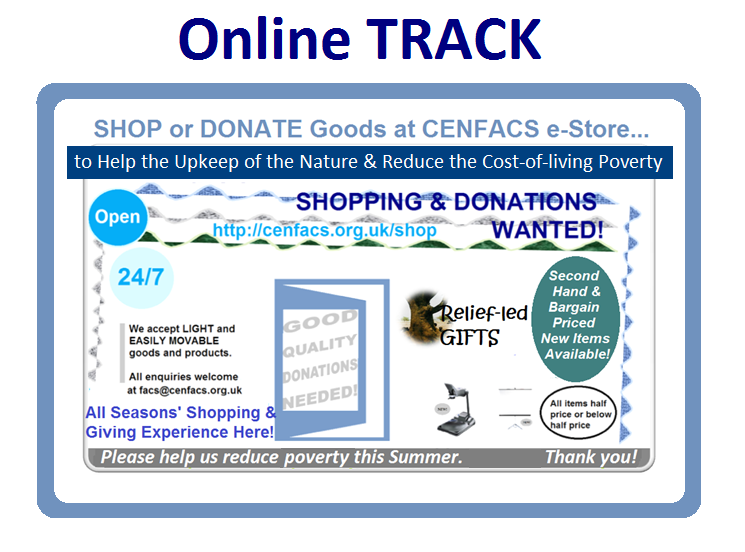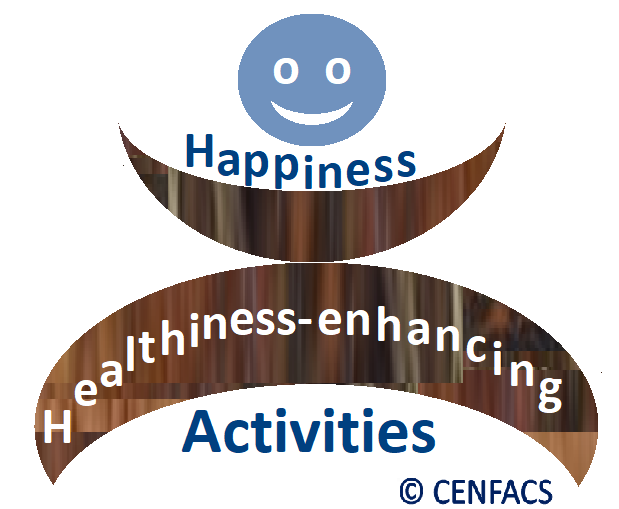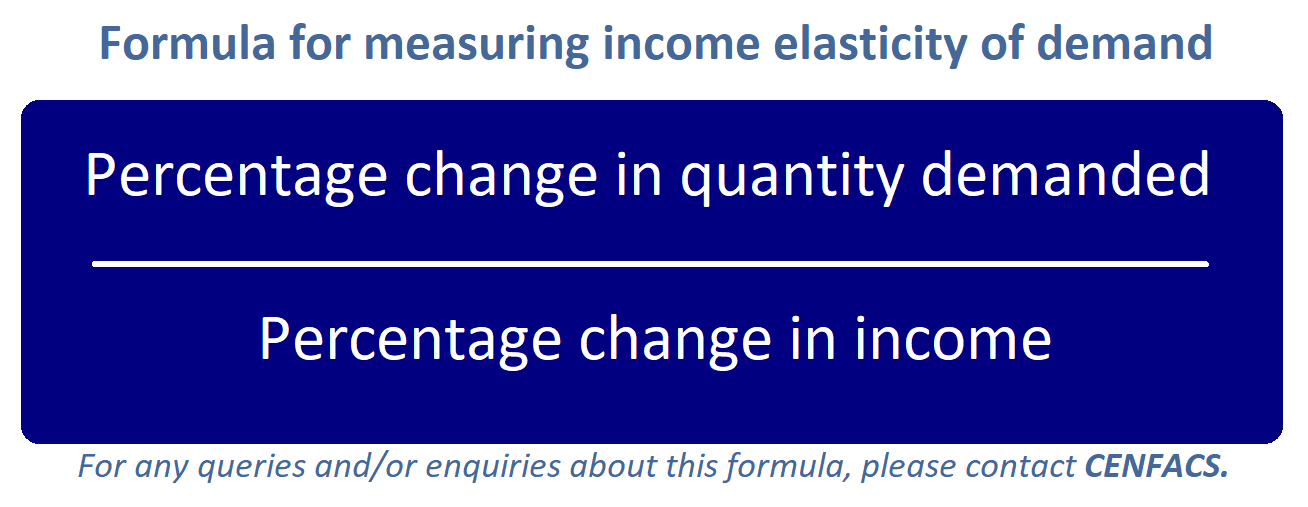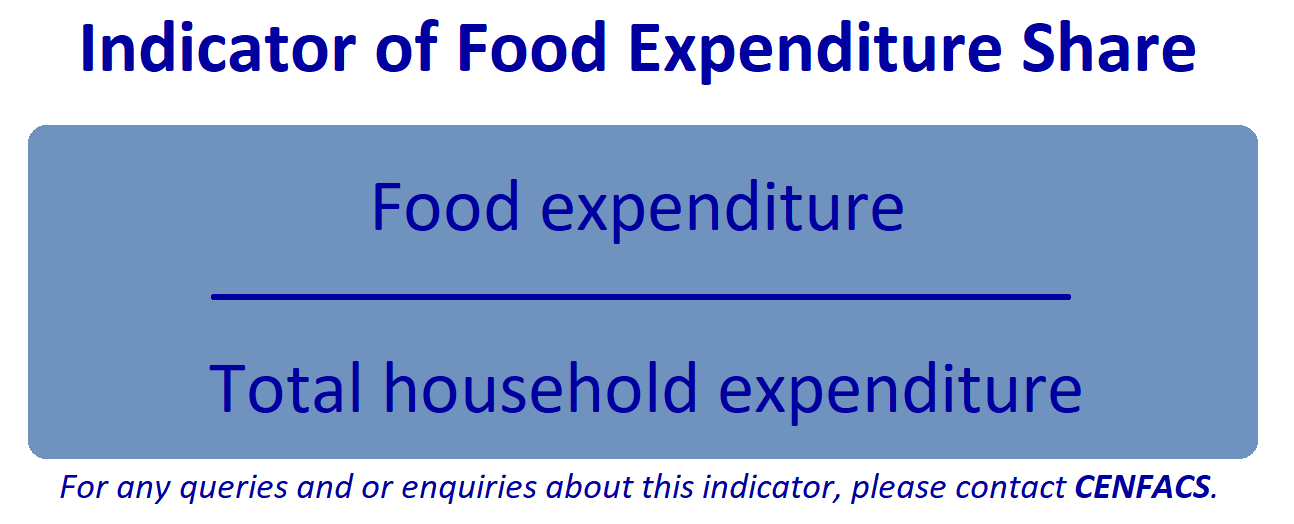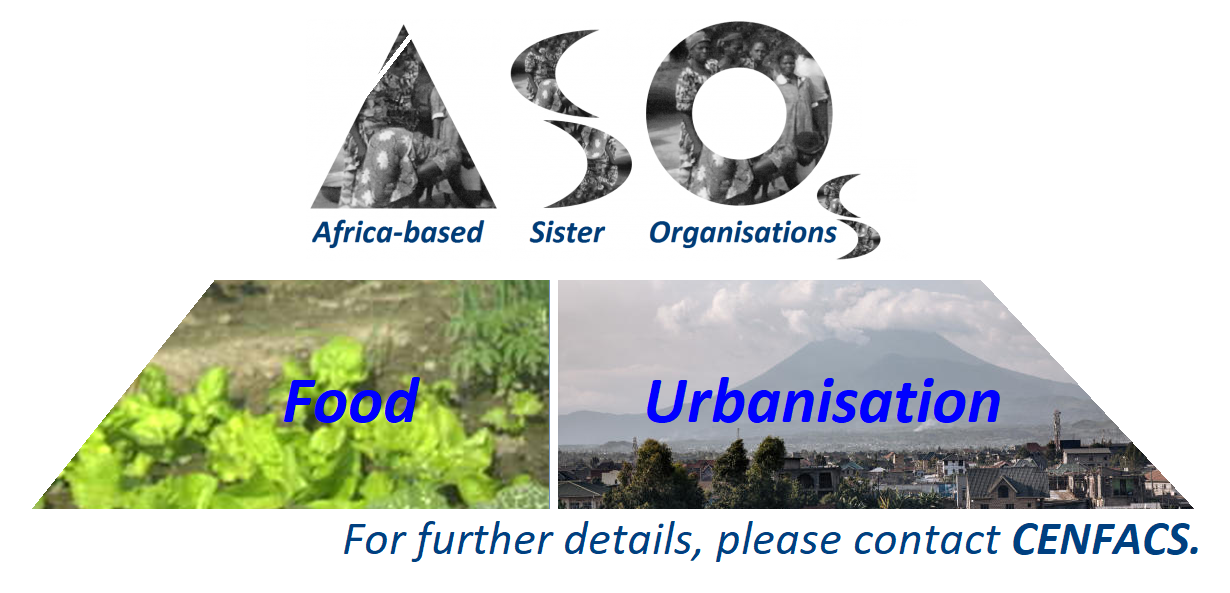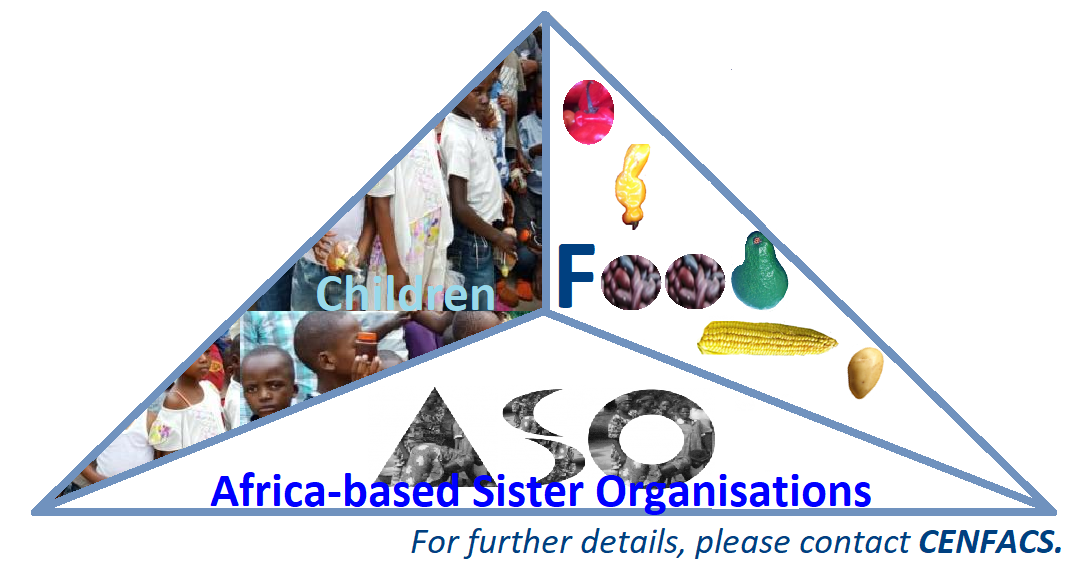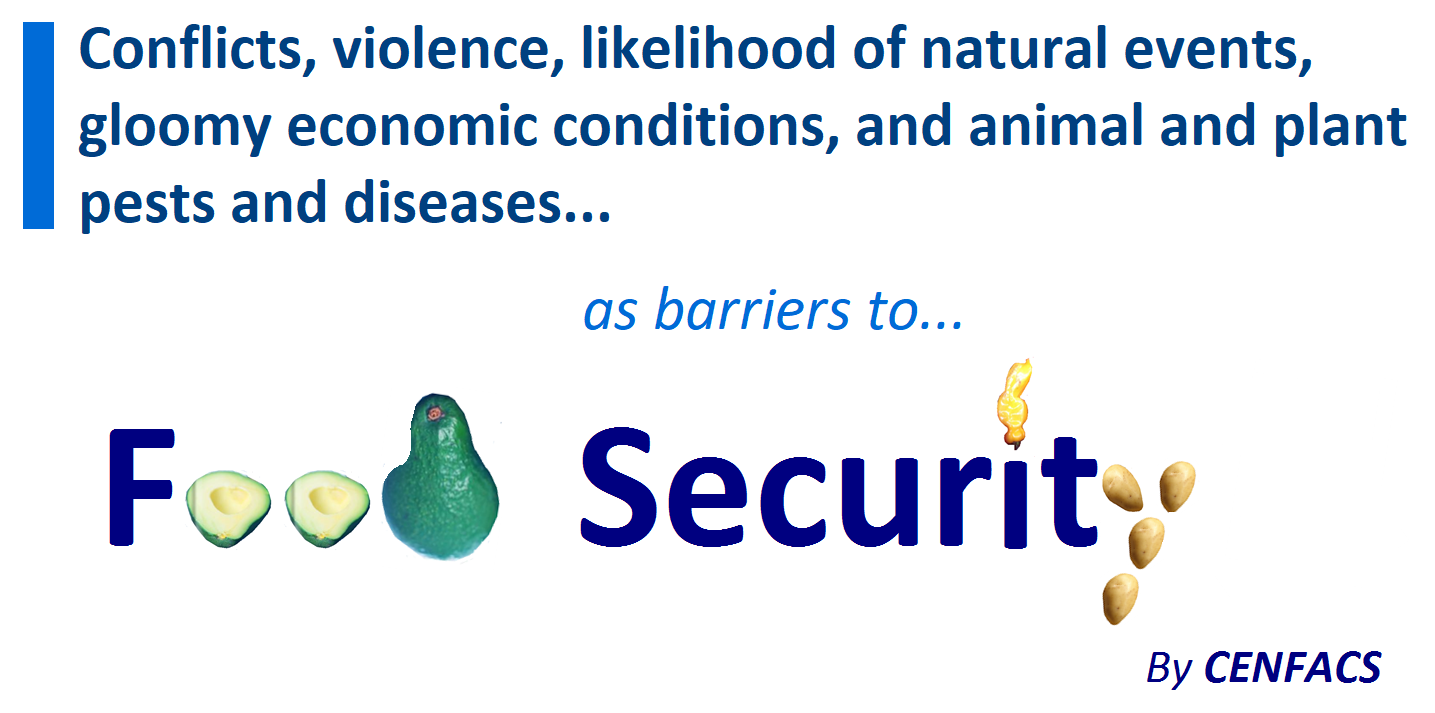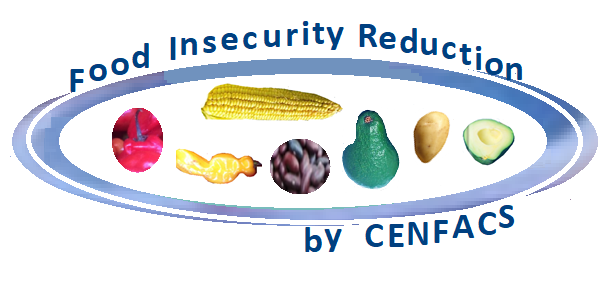Welcome to CENFACS’ Online Diary!
10 August 2022
Post No. 260
The Week’s Contents
• FACS, Issue No. 76, Summer 2022: Food Security in Africa – Africa-based Sister Organisations Can Make It Happen
• Following the Direction of Poverty Reduction this Summer via Terrestrial Ecosystem Services provided by Forests, Trending Topic in Focus from Week Beginning 08/08/2022: Regulating Services
• Happiness and Healthiness Journal 2022, Creative Activity No. 3: Create Your Journal of Happy and Healthy Life Expectancy
… And much more!
Key Messages
• FACS, Issue No. 76, Summer 2022: Food Security in Africa – Africa-based Sister Organisations Can Make It Happen
The continuous rise in food prices means increased threat level and risk to food security for people, especially for those who are already food poor. Where there is threat, there could be opportunity as well. It is the opportunity that Africa-based Sister Organisations (ASOs) have to help bring food security to their users and communities which makes the essential substance of the 76th Issue of FACS.
Indeed, the 76th Issue focuses on the contribution that CENFACS‘ Africa-based Sister Organisations can make for food security to happen in Africa, at least in their areas of operation. In this respect, the 76th Issue puts emphasis on efforts deployed by CENFACS‘ Africa-based Sister Organisations in helping to bring food security in those areas.
In the above said focus, the 76th Issue uses agency-led approach as it considers individuals’ inputs in the process that shapes their food systems. It refers as well to sustainability-oriented approach as its includes these three dimensions (i.e. economic, social and environmental) in food security.
The 76th Issue also considers food security analysis and monitoring as provided by World Food Programme (1), which uses food consumption measured by kilocalories.
The 76th Issue, which looks at the effects of food crisis on food security, deals with the four dimensions of food security as defined by the Food and Agriculture Organisation of the United Nations (2), which are: food availability, food access, food utilisation and stability. Far from being a simple description of these dimensions, the 76th Issue puts them in the context of those in need, the food insecure.
To make food security a matter of reality rather than a dream only, the 76th Issue combines theories and data relating to the problem of food security faced by those in most need of food. The Issue then goes on from food coping strategies to exploring ways through which the food poor can navigate in order to achieve the goal of food security.
Food security can be created and innovated. To put this into perspective, the 76th Issue leads its readers by showing ways of creating and innovating food security, especially at this challenging time of the cost-of-living crisis.
Finally, since one cannot speak about food security without talking about food poverty, the 76th Issue provides some good insights into the relationship between security and poverty around the concept of food.
To get a glimpse of the way in which ASOs are trying to make food security happen, please read the summaries presented under the Main Development section of this post.
• Following the Direction of Poverty Reduction this Summer via Terrestrial Ecosystem Services provided by Forests, Trending Topic in Focus from Week beginning 08/08/2022: Regulating Services
The 2nd trending topic of our activity in following the direction of poverty reduction via terrestrial ecosystem services provided by forests is Regulating Services.
In this 2nd trending topic, we would like to look at the meaning of Regulating Services and the way in which we are going to follow the direction of poverty reduction via these services.
• • Basic meaning of Regulating Services
Before looking at the definition of regulating services, it is worth mentioning that within the literature regarding regulating services some writers speak about regulating services while others prefer the expression regulation services. However, by looking at the two expressions, they both mean the same thing.
For instance, the Food and Agriculture Organisation of the United Nations (3) ague that
“Maintaining the quality of air and soil, providing flood and disease control, or pollinating crops are some of the ‘regulating services‘… They are often invisible and therefore taken for granted. When they are damaged, the resulting losses can be substantial and difficult to restore”.
Among those talking about regulation services, we can mention Climate Woodlands (4) which contend that
“Forests provide the following natural process regulation services: air quality regulation, macro-climate regulation, micro-climate regulation, water filtration, erosion control, improvement of human health, post regulation, pollination and natural disaster mitigation.
Whether one talk about regulating or regulation services, these are the services we would like to look at in terms of our journey with them to poverty reduction.
• • Following the direction of poverty reduction via Regulating Services
What is important here is how the above mentioned services help humans to reduce poverty or how they are accompanying humans in their journey of poverty reduction. To find out how these services are contributing to poverty reduction, one may need to follow the direction of poverty reduction via these regulating services. In other words, one needs to take a journey through or with these services and find out how they are helping to reduce poverty.
For example, if one considers what Climate Woodlands (op. cit.) argue about improvements of human as one of the regulation services; then it is possible to notice via the follow up exercise this:
~ Forest trees can help reduce health poverty or issue, particularly stress and mental health
~ The role of forests in water filtration can assist in disease prevention as well as in the reduction of poverty linked or created by the lack of forests’ role in water filtration
~ Forests contribute to the reduction of the likelihood of disease-related organisms to be caught by humans, and amongst them are the poor ones.
The above examples show that by following the direction of poverty reduction via regulating services, it is possible to find more cases that can provide hard evidence on how terrestrial ecosystem services like the regulating ones are contributing to poverty reduction.
To follow the direction of poverty reduction via regulating services with us, just contact CENFACS.
• Happiness and Healthiness Journal, Creative Activity No. 3: Create Your Journal of Happy and Healthy Life Expectancy
COVID-19 has challenged, threatened and in some situations destroyed many lives and livelihoods. Life expectancy (that is the statistical measure of the average time someone is expected to live) has also been tested as many people got ill from the coronavirus pandemic or had to get a double or treble jab or tested against COVID-19 germs. This can make people unhappy while feeling unhealthy.
Likewise, the cost-of-living crisis can create some doubt about happy and healthy life expectancy. This is because those who cannot afford the cost of living would worry about their life and the future. This worry and the lack of means, particularly financial and psychological means to handle the cost of living, could mean their living has no purpose, no meaning and no expectation.
Furthermore, extreme temperatures that are the result of changing climate can only affect the way we live, eat, dress, shelter, travel, etc. They can challenge set habits, cultures and values. Changing climate can bring some concern for those who cannot cope and do not have support to deal with rising temperatures, drought, etc. This can affect life expectancy or their expectation to live longer as well.
So, as part of Summer of Happiness and Healthiness, one can create a journal for the things that and people who are bringing or have brought expectation of living a happy and healthy life during this Summer of rising costs of living, changing climate and lingering effects of the coronavirus.
They can record their thoughts, feelings, experiences and memories in relation to their life expectancy or the expectation of it. They can share with the community their experience of happy and healthy life expectancy. This can be recorded in their journal and be shared by the end of Summer 2022.
To share the contents of their happiness and healthiness journal relating to happy and healthy life expectancy, and help build a better Summer holiday experience, they can contact CENFACS.
Extra Messages
• Online TRACK to CENFACS e-charity Summer Shop for Summer Goods Donations and Buys
Every season is an opportunity to do something about the environment and poverty.
You can recycle or donate your unwanted or unused goods and presents to do something about the environment and or poverty.
You can also buy goods to meet the same ends.
This Summer you can online track CENFACS e-charity shop to help the environment and poverty relief.
If you are a fun of online tracking and shopping, you can take an online course of action or online path or even course of travel to save the environment and reduce poverty with CENFACS.
Instead of you in-person going to physically shop or donate your goods, you can from the comfort of your home buy or donate goods to CENFACS e-charity shop to help the deserving and noble cause of poverty relief and sustainable development.
To support us either by shopping or supplying us with products or goods you no longer want or use so that we can sell and raise the money for the good cause of poverty relief, please go http://cenfacs.org.uk/shop/
• Virtual and In-person Trips for Field Research
Trips to the local need this week include as well those travels made or to be made to conduct fieldwork research in Africa and anywhere else in the context of poverty relief and sustainable development projects.
Because of the lingering effects of the coronavirus, we recommend to those who want do trips for field research to only do them virtually. Where these effects are nullified or minor people can in-person visit local projects and those running them.
When in-person visiting projects and people, it is in the interest of everybody that they should take care of the following:
√ They have to be fully vaccinated and or negatively tested against the coronavirus
√ They should wear appropriate personal protective equipment to protect themselves and others against the COVID-19 if the latter is still a major threat to health
√ They should follow local, national and international rules related to the protection against COVID-19.
These fieldwork researches or practical experiences to gain knowledge and skills could be of varying forms such as observation and collection of raw data, interviews, focus group discussions, practical activities to support overseas development projects, etc.
If you are a researcher and did or are doing some fieldwork research on sustainable development and poverty reduction, and think that your work can enhance CENFACS’ work, you could share with us your experience, research findings or outcomes.
To share the experiences and results of your fieldwork research, just contact CENFACS and CENFACS will get back to you.
• Happiness and Healthiness Enhancing Initiatives
There are initiatives that help to stay happy and healthy over Summer or at any time. What are they?
• • Types of Happiness and Healthiness Enhancing Initiatives
They could be truly engaging happiness- and healthiness-boosting activities catering for groups, families, kids and individuals or people of different abilities and various needs.
They include games, apps spiritual and physical activities.
These activities could be from and within or outside CENFACS.
• • Looking for Activities to Stay Happy and Healthy
For those who are looking for activities to stay happy and healthy but do not know where to start, they can contact CENFACS so that we can together discuss their needs and source any suitable activity for them.
To help us help them, they need to have some ideas or suggestions of the things or activities they would like to undertake.
Need help and support to find happiness and healthiness enhancing activities, please do not hesitate to contact CENFACS.
Message in French (Message en français)
Vient de paraître pour vous accompagner pendant cette période estivale: le 76e numéro de FACS
FACS, numéro 76, été 2022 : Sécurité alimentaire en Afrique – Les organisations sœurs basées en Afrique peuvent y arriver
La flambée des prix des denrées alimentaires qui continue signifie un niveau de menace accru pour la sécurité alimentaire des populations, en particulier pour celles qui sont déjà pauvres en nourriture. Là où il y a une menace, il pourrait aussi y avoir des opportunités. C’est cette opportunité que les organisations sœurs basées en Afrique tentent de prendre afin d’aider à apporter la sécurité alimentaire à leurs utilisateurs et à leurs communautés; ce qui fait la substance essentielle du 76e numéro de FACS.
En effet, le 76e numéro se concentre sur la contribution que les organisations sœurs du CENFACS basées en Afrique peuvent apporter à la sécurité alimentaire en Afrique, au moins dans leurs zones d’opération. À cet égard, le 76e numéro met l’accent sur les efforts déployés par les organisations sœurs du CENFACS basées en Afrique pour aider à apporter la sécurité alimentaire dans ces zones.
Dans l’objectif susmentionné, le 76e numéro utilise une approche dirigée par l’agence car il prend en compte les contributions des individus dans le processus qui façonne leurs systèmes alimentaires. Il se réfère également à une approche axée sur la durabilité car elle inclut les trois dimensions (c’est-à-dire économique, sociale et environnementale) de la sécurité alimentaire.
Le 76e numéro examine également l’analyse et le suivi de la sécurité alimentaire fournis par le Programme Alimentaire Mondial qui utilise la consommation alimentaire mesurée en kilocalories.
Le 76e numéro, qui examine les effets de la crise alimentaire sur la sécurité alimentaire, traite des quatre dimensions de la sécurité alimentaire telles que définies par l’Organisation des Nations Unies pour l’Alimentation et l’Agriculture (2), à savoir: la disponibilité alimentaire, l’accès aux aliments, l’utilisation des aliments et la stabilité. Loin d’être une simple description de ces dimensions, le 76e numéro les replace dans le contexte de ceux ou celles qui sont dans le besoin, de l’insécurité alimentaire.
Pour faire de la sécurité alimentaire une question de réalité plutôt qu’un rêve, le 76e numéro combine des théories et des données relatives au problème de la sécurité alimentaire auquel sont confrontés ceux ou celles qui en ont le plus besoin. Le numéro passe ensuite des stratégies d’adaptation alimentaire à l’exploration des moyens par lesquels les pauvres en alimentation peuvent naviguer afin d’atteindre l’objectif de la sécurité alimentaire.
La sécurité alimentaire peut être créée et innovée. Pour mettre cela en perspective, le 76e numéro guide ses lecteurs en montrant des moyens de créer et d’innover en matière de sécurité alimentaire, en particulier en cette période difficile de crise du coût de la vie.
Enfin, puisqu’on ne peut pas parler de sécurité alimentaire sans parler de pauvreté alimentaire, le 76e numéro donne un bon aperçu de la relation entre la sécurité et la pauvreté autour du concept d’alimentation.
Pour avoir un aperçu de ce 76e numéro et de la façon dont les organisations sœurs basées en Afrique tentent de faire en sorte que la sécurité alimentaire se produise, veuillez contacter le CENFACS.
Main Development
• FACS, Issue No. 76, Summer 2022: Food Security in Africa – Africa-based Sister Organisations Can Make It Happen
The contents and key summaries of the 76th Issue of FACS are given below.
• • Contents and Pages
∝ Key Concepts Relating to Food Security (Page 2)
∝ Income Elasticity of Demand for Staple Products During this Time of Rising Food Prices (Page 3)
∝ Share of Food Expenditure in Total Household Expenditure During this Time of Rising Food Prices (Page 3)
∝ ASOs’ Response to Food and Nutrition Problems Posed by Rapid Urbanisation in Africa’s Mega Cities (Page 4)
∝ ASOs, Food Insecurity and Children (Page 4)
∝ Créations et innovations sur la sécurité alimentaire pour atténuer la crise du coût de la vie en Afrique (Page 5)
∝ Organisations sœurs basées en Afrique face à la double insécurité civile et alimentaire (Page 5)
∝ Les Organisations sœurs basées en Afrique et la protection de leurs utilisateurs contre l’insécurité alimentaire (Page 6)
∝ Comment les Organisations sœurs basées en Afrique travaillent avec les pauvres en alimentation pour se frayer un chemin vers l’objectif de sécurité alimentaire (Page 6)
∝ Survey, E-questionnaire and E-discussion on Food Security (Page 7)
∝ Support, Top Tool, Information and Guidance on Food Security Matters (Page 8)
∝ Workshop, Focus Group and Enhancement Activity about Food Security (Page 9)
∝ Giving and Project (Page 10)
• • Key Summaries
Please find below the key summaries of the 76th Issue of FACS from page 2 to page 10.
• • • Key Concepts Relating to Food Security (Page 2)
There are four concepts that will help the readers of FACS to better understand the contents of the 76th Issue. These concepts are: food security, acute food insecurity, inflation-adjusted food price index and food poverty line. These concepts also shape the 76th Issue of FACS.
Let us briefly explain them.
• • • • Food security
The explanation of food security comes from the glossary of Food and Agriculture Organisation of the United Nations et al (5) which argue that
“Food security is a situation that exists when all people, at all times, have physical, social and economic access to sufficient, safe and nutritious food that
meets their dietary needs and food preferences for an active and healthy life. Based on this definition, four food security dimensions can be identified: food availability, economic and physical access to food, food utilization and
stability over time. The concept of food security is evolving to recognize the centrality of agency and sustainability” (p.202)
• • • • Acute food insecurity
Acute food insecurity is “any manifestation of food deprivation that threatens lives or livelihoods regardless of the causes, context or duration”, according to the World Food Programme and the Food and Agriculture Organisation of the United Nations (6).
The Food and Agriculture Organisation of the United Nations et al (op. cit.) also argue that
“Acute food insecurity is food insecurity found in a specified area at a specific point in time and of a severity that threatens lives or livelihoods, or both, regardless of the causes, context or duration. Has relevance in providing strategic guidance to actions that focus on short-term objectives to prevent,
mitigate or decrease severe food insecurity” (p. 200)
• • • • Inflation-adjusted food price index
The FAO (Food and Agriculture Organisation of the United Nations) (7) provides its own index, which is called FAO Food Price Index (FFPI). The FFPI is defined as
“A measure of the monthly change in international prices of basket of food commodities. It consists of the average of five commodity group price indices weighted by the average export shares of each of the groups over [a period, for example] 2014-2016”.
According to the FAO (8),
” The FAO Food Price Index (FFPI) averaged 157.4 points in May 2022, down 0.9 points (0.6 percent) from April, marking the second consecutive monthly decline, though still 29.2 points (22.8 percent) above its value in the corresponding month last year. The drop in May was led by declines in the vegetable oil and dairy price indices while the sugar price index also fell to a lesser extent. Meanwhile, cereal and meat price indices increased” (p.158)
Likewise, the World Economic Forum (9) states that
“The Food Price Index is designed to capture the combined outcome of changes in a range of food commodities, including vegetable, oils, cereals, meat and sugar; and compare them month to month”.
According to this World Economic Forum (op. cit.), the index needs to be adjusted for inflation. When prices are adjusted for inflation, they are real.
• • • • Food poverty line
As to food poverty line, it is defined by ‘devinit.org’ (10) as
“the cost of a basket of food with minimum recommended nutritional intake. This metrics can be used to quantify consumption poverty”.
The above mentioned concepts will be used in understanding the way in which ASOs (like African Food Security Urban Network) are trying to make food security happen to their users and communities. They would as well be put in practice to assess the vulnerability of those of our members in most need to the upheavals of the global and local food markets, and work with them to overcome this vulnerability.
• • • Income Elasticity of Demand for Staple Products During this Time of Rising Food Prices (Page 3)
Income elasticity of demand for staple products is part of an applied research project within CENFACS. The aim of this applied research project is to find out if the fall in real income of CENFACS Community members (as result of the hike in the cost of living) is leading these members to spend more or less on staple products or basic foodstuffs (e.g. bread, sunflower oil, potatoes, etc.).
For example, because of the Ukraine war the price of 1 litre of Vita D’or sunflower oil has dramatically increased. It was £1.65 in Lidl at the time of composing these notes. Bearing in mind that Lidl is a budget food store, it could cost even more in other food stores or supermarkets.
This aim of our applied research project can be translated into economic terms as the income elasticity of demand for staple products. This elasticity is a measure of the degree of responsiveness of demand for any staple products to a given change in income.
The findings from this applied research project will enable us to quantify if their demand is income elastic or inelastic or neutral as well as to know how the rising food prices are affecting them.
• • • Share of Food Expenditure in Total Household Expenditure During this Time of Rising Food Prices (Page 3)
Share of food expenditure in total household expenditure is another study we are conducting. The aim of this study is to find out economic vulnerability and resilience from the members of our community concerning their ability to have a basket of food with minimum recommended nutritional intake.
As the World Food Programme (11) puts it
“The food expenditure share (FES) is an indicator used to measure households economic vulnerability. The higher the share of households’ expenditure on good out the total expenditure, the more vulnerable the households are to food insecurity”
Depending on households, food expenditure can be flexible whereas other household expenses could be fixed for a period. For example, rent, utility bills, council tax, etc. could be fixed for the duration of rental agreement.
However, at the time of the cost of living crisis characterised by interest rate at 1.75% and inflation at around 9.4% and expected to hit 13% in Autumn in the UK; most of the prices and bills, including those of food, have gone up.
Rising food prices may affect the share of food expenditure in total household expenditure for many households, including our users. The study will help to know how vulnerable and resilient our members of the community are in face of rising commodity prices, inflation and interest rate. The findings of this study will as well enable to create and innovate ways of working with the community following the emerging needs that the study will generate.
For further details and or enquiries about these two Research and Development activities, please do not hesitate to contact CENFACS.
• • • ASOs’ Response to Food and Nutrition Problems Posed by Rapid Urbanisation in Africa’s Mega Cities (Page 4)
Rapid urbanisation in Africa’s mega cities (like Lagos, Cairo, Kinshasa, etc.) means more demand for food and other nutritional stuffs. At this time of the cost-of-living crisis, it is even challenging to feed extra mouths, especially in Africa’s mega cities where there is already a high level of food poverty and other forms of urban poverty.
ASOs operating in those cities are working with those in need of food and other life-sustaining goods and services to try to address the issue of food insecurity amongst city poor inhabitants. But, they need help and support to deal with the gigantic task of making food security to happen since food security can collude with urban poverty and food poverty.
• • • ASOs, Food Insecurity and Children (Page 4)
Food insecurity is prevalent in many areas of operation of our ASOs in Africa, especially in areas strongly affected by armed conflicts, climate change and the cost-of-living crisis. The situation in those areas of Africa is that many children live on a very limited diet and without variety quite often. This can widen inequality in food security as there is no access to and consumption of a healthy diet for these children.
ASOs working on programmes and projects to address food insecurity for children living in deprived areas are undertaking some food security initiatives in order to reach these children and address food insecurity amongst them.
• • • Créations et innovations sur la sécurité alimentaire pour atténuer la crise du coût de la vie en Afrique (Page 5)
La crise de sécurité alimentaire fait que les populations locales ou les bénéficiaires de projets avec leurs organisations créent et innovent sur la route de l’alimentation pour lutter contre le coût élevé de la vie en Afrique.
Ces créations et innovations concernent aussi bien la manière dont les nouveaux aliments sont produits que le système d’approvisionnement alimentaire. Parmi ceux-ci, on peut citer des produits tels que l’huile de palme et d’arachide produite localement. En utilisant des noix de palme, les bénéficiaires de projets peuvent produire de l’huile pour répondre à leurs besoins en matière de préparation des aliments.
Il existe plusieurs exemples qui montrent la montée en puissance des initiatives locales pour surmonter le problème de l’insécurité alimentaire. Pour ceux ou celles qui s’intéressent à ces initiatives et au travail des organisations africaines pour avancer sur la voie de la sécurité alimentaire individuelle et communautaire, ils/elles peuvent contacter le CENFACS.
• • • Organisations sœurs basées en Afrique face à la double insécurité civile et alimentaire (Page 5)
Les zones touchées par le conflit et l’accès sont également des endroits où de nombreuses personnes ont besoin de nourriture. Dans ces zones, il y a des personnes touchées par des crises dans des pays tels que le Burkina Faso, la République Centrafricaine, la République Démocratique du Congo, le Mali, le Niger, le Tchad, etc.
Dans ce climat délétère d’insécurité civile, des Organisations sœurs basées en Afrique opérant dans des zones d’insécurité civile essaient d’assurer l’accès à la nourriture et à d’autres biens de première nécessité. Elles tentent d’empêcher l’insécurité civile de se heurter à l’insécurité alimentaire.
Elles fournissent un soutien qui sauve et maintient des vies des personnes déplacées de force, qui sont généralement touchées par une crise alimentaire croissante en raison de l’insécurité civile.
• • • Les Organisations sœurs basées en Afrique et la protection de leurs bénéficiaires de projet contre l’insécurité alimentaire (Page 6)
En général, les Organisations sœurs basées en Afrique fournissent les services suivants dans leur zone d’opération:
√ Aider à éviter les conflits entre les communautés agricoles et les communautés pastorales sur les questions d’alimentation et d’eau
√ Soutenir les familles qui ont été forcées de quitter leur maison ou leur terre pour chercher de la nourriture et de l’eau
√ Essayer de rendre les besoins et les capacités alimentaires disponibles sur le terrain, en particulier en cette période difficile de crise du coût de la vie.
Il y a plus de services et d’activités qu’elles fournissent. Pour ceux ou celles qui veulent en savoir plus sur ce sujet, ils/elles peuvent contacter le CENFACS.
• • • Comment les Organisations sœurs basées en Afrique travaillent avec les pauvres en alimentation pour se frayer un chemin vers l’objectif de sécurité alimentaire (Page 6)
L’objectif de la sécurité alimentaire est celui de la disponibilité, l’accès, l’utilisation et la stabilité des aliments dans le temps.
Pour atteindre cet objectif, les gens ne devraient pas compter entièrement sur le marché. Le marché ne peut pas satisfaire tout le monde, en particulier ceux ou celles qui ont peu de revenus ou sans revenu.
Les gens peuvent prendre toutes sortes d’initiatives comme celles-ci: cultiver leur propre nourriture, acheter de la nourriture en vrac, mieux planifier le stock alimentaire (par exemple en achetant un sac de manioc, de riz, de maïs, de sucre, de sel, etc. lorsque les prix sont bas), s’entraider au sein de la communauté et ainsi de suite.
Les gens utilisent toutes sortes de stratégies d’adaptation pour répondre aux besoins alimentaires de leur ménage. Ceux qui ont un jardin peuvent planter et récolter certains types de légumes (comme les épinards) et de fruits (comme les tomates, les arachides, etc.). D’autres peuvent même exploiter une petite ferme avicole pour répondre aux besoins de consommation de leur ménage.
Ce qui précède est l’une des nombreuses façons de marcher vers l’objectif de la sécurité alimentaire.
Pour ceux ou celles qui voudraient aller plus loin dans cet objectif, ils/elles peuvent contacter le CENFACS.
• • • Survey, E-questionnaire and E-discussion on Food Security (Page 7)
• • • • Food Security Survey
This survey aims to support those who are struggling to have food security and avoid food poverty at this time of rising costs and prices of food.
As part of the survey, we are running a questionnaire. One of the questions is:
How are you coping with food security (that is food availability, access, utilisation and stability) at this challenging time of rising costs and prices of food?
You can directly send your answer to CENFACS.
To help people respond, they can think of any coping strategies to achieve the aim of food security. Coping strategies are defined by the Food and Agriculture Organisation of the United Nations et al as
“Activities to which people resort in order to obtain food, income and/or other essential goods or services when their normal means of livelihood have been disrupted or other shocks/hazards affect their access to basic needs”.
You can refer to this definition and respond. Your response can help shape our campaign about Making Zero Hunger Africa.
• • • • E-questionnaire on Actionable Food Security Information
Do you have enough information on food security?
If your answer is NO, CENFACS can work with you via its Information and Guidance on Food Security to help you find the information you need on food security.
• • • • E-discussion on Reduce For Quick Sale (RFQS) Items and Food Poverty Reduction
RFQS are those items or products past their best goods found in the bargain bins placed discretely around stores. Many consumers or shoppers, especially those on low income brackets, who are goods price hunters, will look for RFQS to make their consumption ends meet.
If you are one of the RFQS hunters living on a tiny budget have the opportunity to buy these bargain goods; RFQS can make a great deal by helping you to reduce poverty. And if you are food poor or in need of food, RFQS can assist you to reduce food poverty or at least to save money on your food purchase.
For those who had this experience on how RFQS has helped them to reduce consumption poverty or save on food purchase, they can join our e-discussion to exchange their views with others.
To e-discuss your RFQS experience, please contact CENFACS.
• • • Support, Top Tool, Information and Guidance on Food Security Matters (Page 8)
• • • • Ask CENFACS for Food Security Support
Under CENFACS’ Advisory Support for the Impacted of the Cost-of-Living Crisis, you can ask for support to deal with the struggle you are having to meet rising costs of food.
• • • • Top Tool of the 76th Issue: Global Food Security Index
According to the UNCCD (United Nations Convention to Combat Desertification) (12),
“Food security is defined as the state in which people at all times have physical, social and economic access to sufficient and nutritious food that meets their dietary needs for a healthy and active life”.
The same UNCCD argues that
“The Global Food Security Index considers the core issues of affordability, availability, and quality across a set of 113 countries. The index is a dynamic quantitative and qualitative scoring model, constructed from 28 unique indicators, that measures these drivers of food security across both developing and developed countries. The overall goal of the study is to assess which countries are most and least vulnerable to food insecurity through the categories of Affordability, Availability, and Quality and Safety”.
This tool can be customised and brought to individual level to assess how for example any of our members is vulnerable to food insecurity and what areas of vulnerability we can work together with them so that they navigate their way to food security.
To discuss the relevancy of this tool for our community, please contact CENFACS.
• • • • Information and Guidance on Food Security
You can request from CENFACS a list of organisations and services providing help and support in the area of food security. Likewise, we can inform and direct or guide you to find organisations that provide food at prices and conditions that match your food security level.
To make your request, just contact CENFACS with your name and contact details.
• • • Workshop, Focus Group and Enhancement Activity about Food Security (Page 9)
• • • • Mini Workshop
Boost your knowledge and skills about food security via CENFACS.
To enquire about the boost, please contact CENFACS.
• • • • Focus Group on Food Insecurity
You can take part in our focus group on widening inequality in access to and consumption of healthy foods since the cost-of-living crisis began.
To take part in the focus group, please contact CENFACS.
• • • • Summer Food Security Enhancing Activity
How to use Food Security Risk Index to work out your own household food security risk
The index will help you find out your risk-aversion and vulnerability to rising prices of food.
To take part in this activity, please contact CENFACS.
• • • Giving and Project (Page 10)
• • • • Readers’ Giving
You can support FACS, CENFACS‘ bilingual newsletter, which explains what is happening within and around CENFACS.
FACS also provides a wealth of information, tips, tricks and hacks on how to reduce poverty and enhance sustainable development.
You can help to continue its publication and to reward efforts made in producing it.
To support, just contact CENFACS on this site.
• • • • Food Security Project (FSP)
With rising costs and prices of food, food insecurity has now become a common currency especially for those who always struggle to make ends meet. To address the level of insecurity and threat posed by food insecurity to these struggling people there is a need to develop appropriate response.
FSP, which may not be a panacea, can help to work with food insecure people so that they can progressively navigate their way towards food availability, access, utilisation and stability. In doing so, they can potentially avoid food poverty. FSP will help to level up those who are looking for sustainable solutions to food crisis.
To support or contribute to FSP, please contact CENFACS.
For further details including full project proposals and budget about the Food Security Project, please contact CENFACS.
The full copy of the 76th Issue of FACS is available on request. For any queries and comments about this Issue, please do not hesitate to contact CENFACS.
_________
• References
(1) https://www.wfp.org/food-security-analysis (accessed in August 2022)
(2) FAO, IFAD, UNICEF, WFP and WHO (2021), The State of Food Security and Nutrition in the World 2021: Transforming food systems for food security, improved nutrition and affordable healthy diets for all, Rome at https://doi.org/10.4060/cb4474en (accessed in August 2022)
(3) https://www.fao.org/ecosystem-services-biodiversity/background/regulating-services/en (accessed in August 2022)
(4) https://climate-woodland.extension.org/natural-process-regulation-ecosystem-services/ (accessed in August 2022)
(5) FAO, IFAD, UNICEF, WFP and WHO (2022), The State of Food Security and Nutrition in the World 2022: Repurposing food and agricultural policies to make healthy diets more affordable, Rome, FAO (https://doi.org/10.4060/cc0639en) (accessed in August 2022)
(6) WFP and FAO (2022), Hunger Hotspots, FAO-WFP early warnings on acute food insecurity, February to May 2022 Outlook, Rome. https://doi.org/10.4060/cb8376en
(7) https://www.fao.org/worldfoodsituation/foodpricesindex/en/ (accessed in April 2022)
(8) FAO (2022), Food Outlook – Biannual Report on Global Food Markets, Rome (https://doi.org/10.4060/cb9427en (accessed in August 2022)
(9) https://weforum.org/agenda/2021/10/global-food-prices-global-global-food-price-index (accessed in April 2022)
(10) https://www.devinit.org/org/resources/food-poverty-global-regional-and-national/# (accessed in February 2022)
(11) https://resources.vam.wfp.org/data-analysis/quantitative/food-security/food-expenditure-share (accessed in June 2022)
(12) https://www.unccd.int/resources/konwledge-sharing-system/global-food-security-index (accessed in August 2022)
__________
• Help CENFACS keep the Poverty Relief work going this year
We do our work on a very small budget and on a voluntary basis. Making a donation will show us you value our work and support CENFACS’ work, which is currently offered as a free service.
One could also consider a recurring donation to CENFACS in the future.
Also, we would like to inform you that planned gifting is always an option for giving at CENFACS.
Donate to support CENFACS!
FOR ONLY £1, YOU CAN SUPPORT CENFACS AND CENFACS’ NOBLE CAUSES OF POVERTY REDUCTION.
JUST GO TO :Support Causes – (cenfacs.org.uk)
Thank you for visiting CENFACS website and reading this post.
Thank you as well to those who made or make comments about our weekly posts.
We look forward to receiving your regular visits and continuing support throughout 2022 and beyond.
With many thanks.



